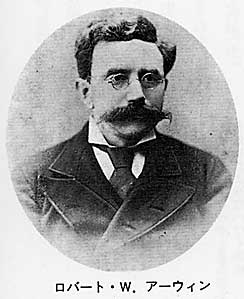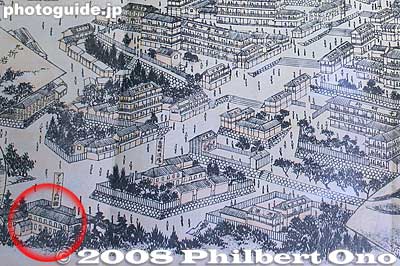This summary is a little bit about some places and events that the Macfarlane family was involved with – some generally known and with us today, some long gone, but the history helps give us some added perspectives.
Henry (Harry) and Eliza Macfarlane settled in Hawaii at Waikiki in 1846, coming from Scotland by way of New Zealand. They purchased/leased the ‘ili of Kaluaokau sometime in the mid-nineteenth century, eventually raising six children there (George Walter, Frederick W, Richard H, Edward Creamer, Helen B (later Cornwell) and Clarence William.)
One lasting legacy at their Kaluaokau home is the banyan tree Henry and Eliza planted – we now more commonly refer to the former home site as the International Market Place.
Among other things, the Macfarlanes owned and operated hotels. One, the Commercial Hotel in downtown Honolulu, has a notable claim to fame – Macfarlane brought gas lighting to Hawaiʻi, hanging the first gas lamps over the billiard tables in his Honolulu saloon.
“On Tuesday evening last Mr. E. Burgess opened his spacious billiard saloon at the Commercial Hotel, which was well attended, no doubt the novelty of the room being lit up with gas proving a great attraction. There are four burners … and they filled the large room with a most brilliant light.”
“Mr. Macfarlane is deserving of great credit for his indefatigable exertions in being the first to introduce gas on this Island”. (Polynesian, November 6, 1858) (The next year, Honolulu Gas Company formed and lit-up more of Honolulu.)
The Commercial Hotel was one of Honolulu’s earliest hotels to advertise hot and cold water for baths and showers. It operated as a hotel and saloon until 1903, when the building was torn down. (Hibbard)
They had other property, in Waikīkī. Son, George is credited with building one of the first hotels in Waikīkī (his home turned to hotel) – the Park Beach Hotel near Kapiʻolani Park. CN Arnold later leased the Macfarlane property in 1888.
By 1899, the hotel failed and Macfarlane sold the lease to James Castle, who built Waikīkī’s most impressive mansion, a lavishly furnished four-story home with extensive grounds, an ocean pier and other amenities. He called it Kainalu.
When Castle died, his widow found the beachfront property more than she wished to keep up. Impressed by the charitable work being done by the Elks (the Honolulu Elks Lodge 616 was established on April 15, 1901,) in 1920 she sold them 155,000-square feet on the beach at Waikīkī complete with lavish home, for $1 a square foot.
Between 1954 and 1956, Outrigger Canoe Club made several offers to purchase about half of the Elk’s property. All were refused. Eventually, in 1955, the Elks agreed to lease property to Outrigger. Negotiations continued, and a lease was signed effective November 17, 1956. (In 1958, the Elks razed Kainalu and built a new lodge.)
In 2007, a rent dispute between the Elks and Outrigger Canoe Club was settled by a three-member arbitration panel. Terms of the new rent between the next-door neighbors were not disclosed because of a confidentiality agreement (the Elks, the landowner, were seeking up to $1-million or more a year in rent from the canoe club for a 99-year lease that was renegotiated midway through the term.)
The Macfarlanes had other Waikīkī property. Nearby in Helumoa, the Macfarlanes had other hotel property – the Seaside Hotel. (There is now another “Seaside Hotel” in Waikīkī, but that’s different from the hotel we are discussing here. That other “Seaside” was built in 1970 and has been used by United Airlines as a perk for employees and company retirees.)
Likewise, the Seaside was the annex for the “Royal Hawaiian Hotel;” not the one in Waikiki, the original Royal Hawaiian was in downtown Honolulu located at Richards and Hotel streets. In the 1890s, son, George, ran the Royal Hawaiian and the Seaside Hotels.
It was later acquired by Alexander Young’s Territorial Hotel Company, which operated the Alexander Young hotel in downtown Honolulu. After the lease expired, Matson Navigation received a new lease from landowner Bishop Estate and built what we refer today as the Royal Hawaiian Hotel.
One more thing about George Macfarlane, he was Chamberlain (an officer whose function is in general to attend to the personal needs of the King and regulate the etiquette of the Palace) and Private Secretary to King Kalākaua (and served as the medium of communication between the King and his Ministers.)
When times were tough, George was entrusted with the responsible task of negotiating and floating the first Hawaiian loan in England. The $2,000,000 loan bore interest at 6 per cent per annum; within six months, the bonds commanded 15-per cent premium. (The Morning Call, December 25, 1890)
Son Clarence (in addition to supporting the family operations) also has a notable and lasting claim to fame. A competitive sailor, Clarence invited West Coast sailors to race to the Hawaiian Islands from San Francisco.
The race start was set for summer of 1906; he took his yacht, “La Paloma,” from Honolulu to San Francisco Bay and found the city lying in ruins following the great earthquake 27-days earlier. He changed the starting point to Los Angeles. The starting line is now off the bluffs of Point Fermin in San Pedro and the finish is off the Diamond Head Lighthouse, about 2,560 miles.
The race, the longer of the two oldest ocean races in the world, continues today – we now call it the Transpacific Yacht Race (TransPac.)
Others in the family participated in the family business activities. Likewise, they had property on the Island of Hawaiʻi and operated the Puʻuloa Sheep and Stock Ranch Company (partnership of the Macfarlane family.)
7,000-sheep ran over fee and leased land, including 4,000-acres of the ahupuaʻa of ʻŌuli, extending from the sea, near Kawaihae, to the top of the Kohala range of mountains, as well as other land nearby.
The family left several lasting legacies in the Islands.












































